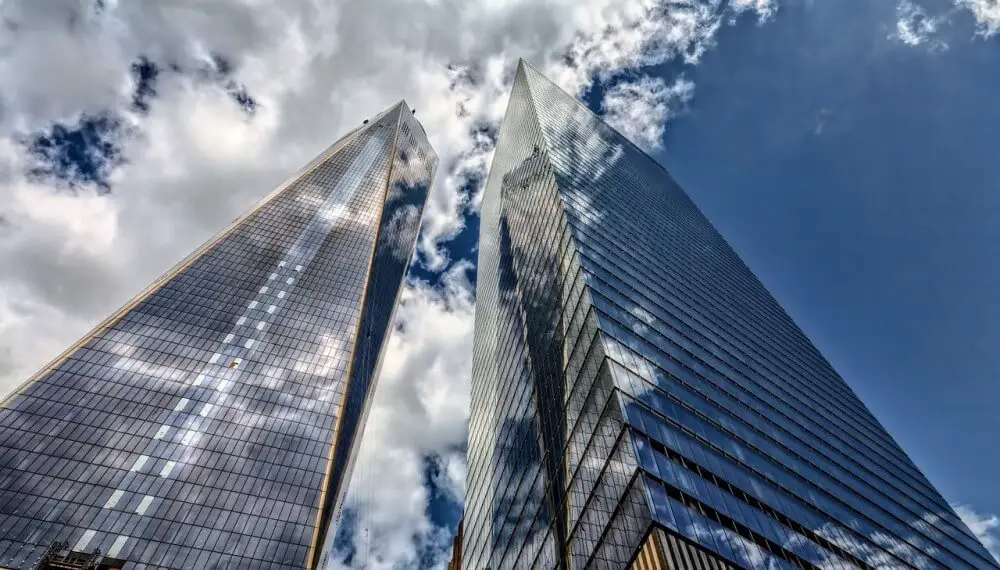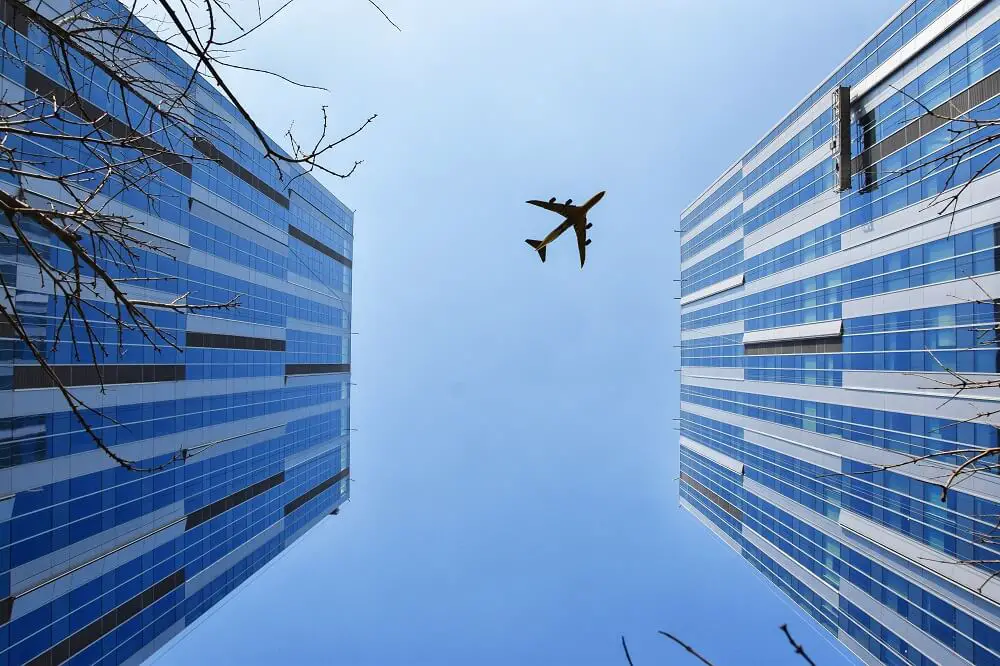If you’ve ever ascended to the top of a tall building on a windy day, chances are you may have felt the ground beneath your feet move. For the uninitiated, this can be a somewhat disconcerting experience.
But, contrary to what you might think, it’s not a problem when skyscrapers sway. In fact, quite the opposite: it’s a marvel of modern engineering and design.
In this guide, we’ll unravel the science, technology, and artistry behind skyscraper sway, providing you with a deep understanding of this phenomenon. Whether you’re a curious enthusiast or an aspiring architect, join us as we delve into this captivating force.
So, with this in mind, let’s explore the question: do skyscrapers sway?

Do skyscrapers sway?
The short answer to whether skyscrapers sway is yes. This motion is usually an inherent characteristic of tall buildings, although there are a number of structural devices that architects use to keep this movement within a safe threshold.
Skyscrapers are designed with a certain level of flexibility to withstand environmental forces, and the materials and techniques involved in their construction allow for controlled movement. Engineers calculate the degree of sway that a building can tolerate without compromising its structural integrity.
To manage sway and maintain occupant comfort, skyscrapers are equipped with sway control systems. These include various technologies like tuned mass dampers, tuned liquid column dampers, and friction dampers. These systems counteract the building’s natural motion, reducing sway and ensuring stability.
So, while skyscraper sway might be unsettling to some, it is essential for the building’s safety. Without the ability to sway, skyscrapers would be more susceptible to structural damage from wind or seismic forces. Sway control systems ensure that the sway remains within safe limits, preventing excessive movement.
Why do skyscrapers sway?
Skyscrapers sway due to a combination of factors, with the three main factors being wind, seismic forces and structural design. On one hand, wind has the power to create high and low pressure on alternating sides of a structure, while seismic forces can shake the ground beneath the building, causing it to sway.
In order to circumvent the effects of this, architects use structural design elements like tuned mass dampers to give the building a threshold of acceptable flexibility, preventing dangerous sway.
Let’s explore these aspects in further detail:
Wind
Wind, as a powerful natural force, can exert substantial pressure on tall buildings. As wind flows around a skyscraper, it creates areas of high and low pressure on different sides of the structure.
This pressure differential results in horizontal forces that push and pull the building, causing it to sway. The taller the building, the greater the surface area exposed to these wind forces, leading to more pronounced sway at higher altitudes.
To explore the potential effects of wind on a tall building, engineers use advanced wind tunnel testing and computational modelling to predict and manage wind-induced sway.
Seismic Forces
In earthquake-prone regions, seismic forces are a significant concern for skyscraper design. During an earthquake, the ground shakes, and this motion is transmitted to the building’s foundations.
Fortunately, the inherent flexibility of skyscraper structures is built to absorb and dissipate the energy generated by seismic activity. Thus, the motion does not spread from the foundations to the building’s superstructure in an unsafe way.
Like with wind, engineers and building designers can employ various strategies to minimise the sway caused by seismic forces, including the use of base isolators and damping systems. These technologies allow the building to move with the ground motion, reducing the risk of structural damage.
Structural Design
The choice of materials used on a tall building or skyscraper also contribute to its flexibility. These materials may include, but are not restricted to, steel and reinforced concrete.
These materials can withstand bending and deformation without failure, rendering the building safe. A skyscraper’s structural system, which includes columns, beams, and the core, is carefully engineered to distribute and manage the forces generated by sway.
This comprehensive approach ensures that the building remains stable even when subjected to extreme environmental conditions.
How do skyscrapers withstand swaying?
Skyscrapers are designed to withstand swaying through a combination of structural engineering, design techniques, and advanced technologies, all aimed at ensuring the safety and comfort of occupants. This multi-faceted approach helps control and manage the sway inherent in tall buildings.
For instance, one fundamental method to control horizontal sway involves strengthening the connections where horizontal girders attach to vertical columns. Typically, construction crews use bolts and welding techniques to secure these connections at the top, bottom, and sides.
As a result, the entire steel superstructure becomes a more unified unit, reducing flexibility and minimising sway.
This also applies to the way the core is constructed. For exceptionally tall skyscrapers, merely tightening structural connections isn’t sufficient. In this case engineers must employ robust core construction techniques, typically involving the central portion of the building. This central core provides additional stability and resistance against sway.
Older skyscrapers, like the Empire State Building and the Chrysler Building, used sturdy steel trusses and diagonal beams around elevator shafts. In contrast, contemporary skyscrapers like the Burj Khalifa often feature concrete cores that have been integrated into their design.
To further enhance comfort and mitigate sway, skyscrapers often incorporate advanced sway control systems. Some buildings, like the Taipei 101 Tower utilise wind-compensating dampers, such as tuned mass dampers.
In these systems, a heavy mass, often constructed from concrete, is shifted back and forth on the upper floors via oil hydraulic systems. A computerised monitoring system tracks wind-induced sway and adjusts the weight’s movement to counteract it effectively.
Similar systems may use massive pendulums to shift the building’s weight in response to movement. This is especially important during earthquakes, when the damper system allows the entire building to move in response to horizontal earth vibrations, reducing the twisting and straining of the steel skeleton.
So, with this information in mind, can it ever be dangerous when a skyscraper sways?

Is it dangerous when skyscrapers sway?
Except in the most extreme and rare cases, it is not dangerous when a skyscraper sways. In most scenarios, people inside a skyscraper won’t even notice the sway, thanks to the building’s sophisticated engineering and damping systems.
Moreover, skyscrapers are subject to rigorous building codes and safety standards. These regulations ensure that they can withstand various environmental forces, including wind and seismic activity. Engineers conduct extensive testing and analysis during the design and construction phases to guarantee that the sway remains within safe limits.
Regular monitoring and maintenance are then conducted to monitor the performance of a tall building or skyscraper. Skyscrapers undergo frequent inspections to ensure their structural integrity, and any issues related to sway control systems or structural components are addressed promptly to maintain safety.
How tall do skyscrapers have to be for them to sway?
It’s not just the tallest buildings that sway – even structures with moderate height of 150 to 200 feet in height can experience levels of swaying. The extent of the sway depends on several factors, including the building’s height, shape, and the stiffness of its structure.
For instance, in a 80 miles per hour breeze, skyscrapers like the CN Tower exhibit discernible sway. The antenna mast of the CN Tower sways approximately three and a half feet, while the upper observation deck sways about one and a half feet.
This movement is deliberate, and necessary to reduce the impact of wind forces on the building’s structure and keep the building stable and safe.
That’s it for our guide to whether skyscrapers sway. So, next time you’re on the sky deck or upper floors of a tall building and you begin to notice the ground beneath you moving, don’t start bolting straight for the exit – it’s all perfectly under control.
Want to learn more about the way skyscrapers work? If so, why not check out our article on why skyscrapers use glass. Or, find out why skyscrapers are called skyscrapers in the first place.
Or, for more definitions on building and architecture vocabulary, take a look at our range of building wikis.
Last Updated on 8 September 2023 by Michael
